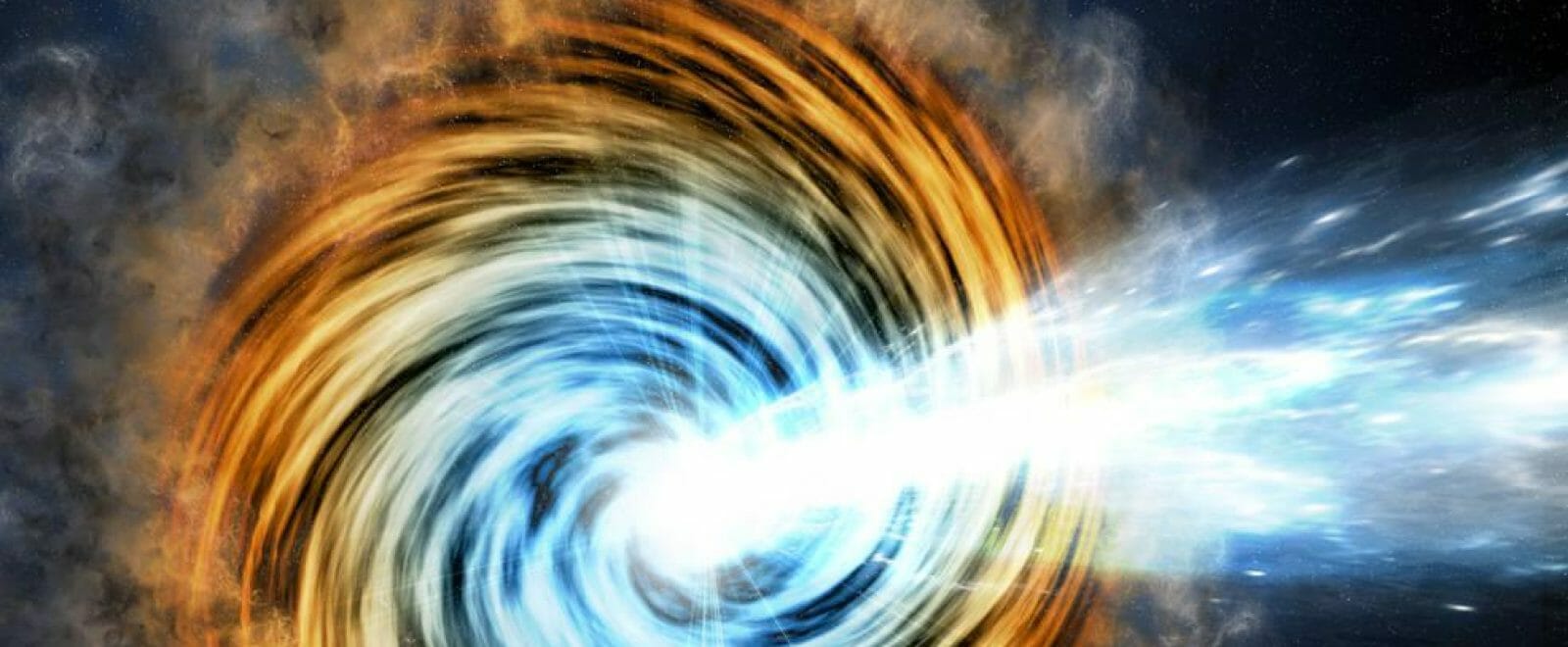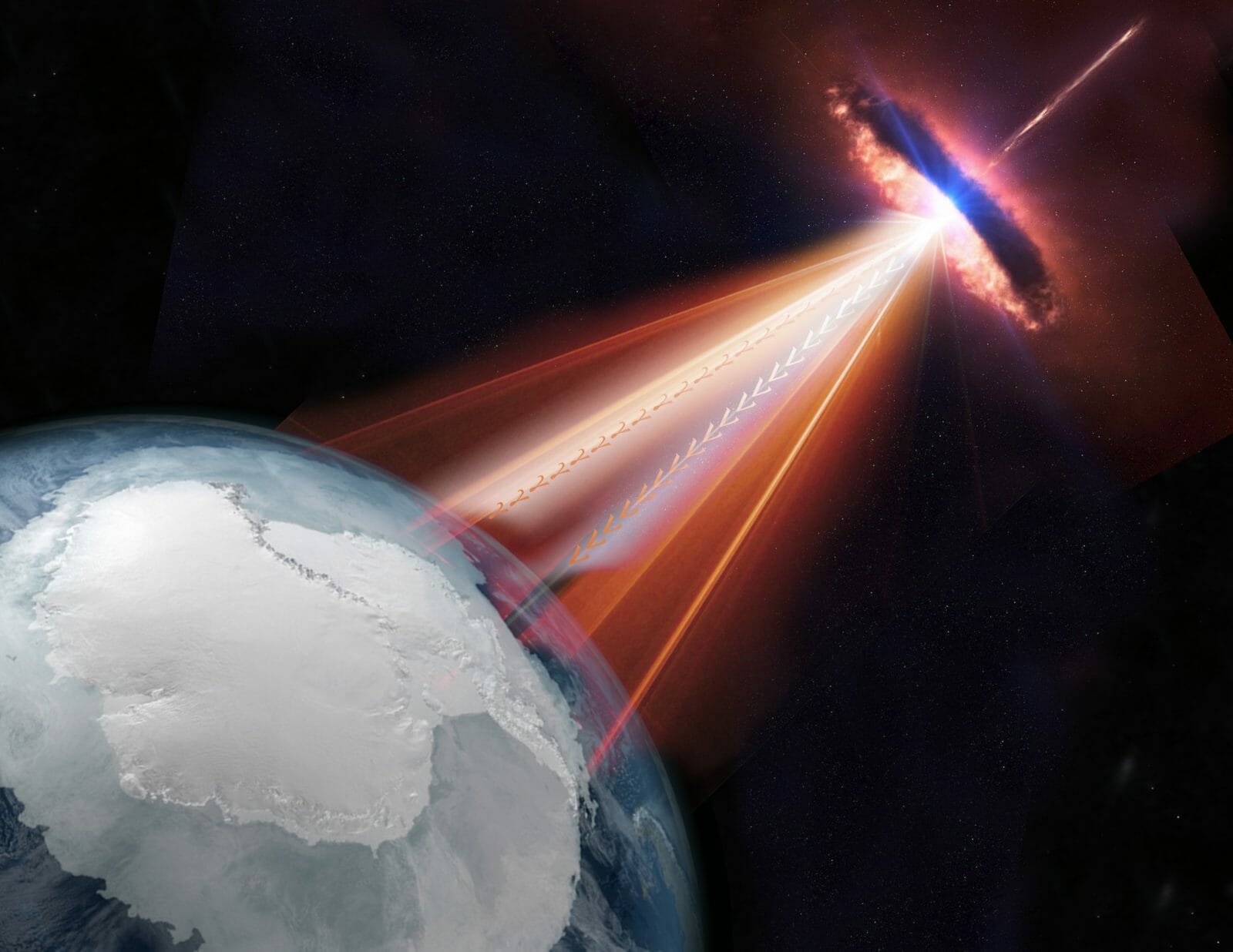
What is a blazar?
Neutrino, Cosmic Ray Discovery Puts Blazars in the Spotlight
Blazars, a type of galaxy powered by a ginormous black hole and among the brightest, most energetic objects in the sky, are not unfamiliar to science.
Many thousands of them have been identified. They belong to a class of galaxies known as “active galactic nuclei” or AGNs, a reference to the supermassive black holes that power them.
Around the black holes are whirling accretion disks made up of matter – dust, gas, stars – being sucked into the black hole. As a blazar’s black hole and accretion disk gobble up matter, the disk heats up and radiates energy across the electromagnetic spectrum, from radio waves to gamma rays. A signature geometric feature of AGNs, including blazars, are twin relativistic jets that shoot from the poles of the rapidly spinning black hole.

Halzen
“The word blazar is only a label for an active galaxy where the jet happens to point toward Earth,” explains Francis Halzen, a University of Wisconsin-Madison professor of physics and the lead scientist for the IceCube Neutrino Observatory. “This of course means we are sitting right in the particle beam being spewed at us by the black hole.”
Halzen is referencing the blazar TXS 0506+056, the apparent source of a high-energy neutrino that on Sept. 22, 2017, slammed into IceCube’s massive detector, made up of a cubic-kilometer of instrumented ice deep beneath the South Pole. Less than a minute after the energetic particle was detected, a public alert was sent to observatories worldwide to look in the direction the neutrino came from in hopes of identifying a source of the cosmic neutrino, a grail of physics and astronomy.

When other telescopes, notably the Fermi Gamma-ray Space Telescope (which is always on and looking in all directions) and the Major Atmospheric Gamma Imaging Cherenkov Telescope or MAGIC, followed up on the IceCube alert, TXS 0506+056 – dubbed “the Texas source” by some astronomers – came into focus from previously gathered observations.
That blazars appear to be a source of the highest energy neutrinos and thus cosmic rays is not a total surprise to scientists. But they did not lead the list of candidate sources and they are probably not the only potential sources, says Halzen, whose IceCube detector was built for the express purpose of finding the cosmic accelerators that send neutrinos, uncharged particles with almost no mass, speeding through the universe.
The reason for that, the Wisconsin astrophysicist explains, is that the blazar’s jets are thought to be “very transparent. They must be because photons escape from them with high energy. We therefore thought there was not enough material in the jet to produce neutrinos, even if protons as well as electrons were present in the jet. A lot of target material means they would become opaque to high-energy gamma rays. Somehow, though, nature balances transparency and neutrino production in the jet.”
The beams are created, says Halzen, as the super-sized black hole at the core of the galaxy eats stars, gas and dust at a frenetic pace. Not all of the material disappears into the black hole, however, as it sometimes saturates and spawns the relativistic jets characteristic of the blazar. Powerful magnetic fields are wound up on the spin axis of the black hole, and particles – photons, protons, neutrinos – are accelerated through the jet and sent coursing through the cosmos.

Karle
“Active galaxies absorb an enormous amount of matter into the central black hole,” says UW-Madison physics Professor Albrecht Karle, one of IceCube’s senior scientists. “But some of the gravitational energy released during the in-fall of matter onto the black hole is converted through the acceleration of charged particles and the emission of electromagnetic radiation, and possibly cosmic rays.”
“Blazars are among the most luminous objects in the sky,” notes Sebastian Heinz, a UW-Madison astronomy professor. “This is because we are seeing them in a very special orientation.”
Their orientation, Heinz adds, makes the jets extremely bright because of what scientists call relativistic Doppler boosting. “At other orientations, their jets would be much dimmer.”
The jets of blazars and other AGNs can extend hundreds of thousands of light years into space, but their bright emissions seem to originate much closer to the black hole, says Heinz.
Blazar jets are also known to flare for periods of time – from minutes to months – increasing their intensity by orders of magnitude. The high-energy neutrino detected by IceCube, says Halzen, seems to be coincident with flaring of the blazar TXS 0506+056 as observed by both the Fermi and MAGIC gamma-ray telescopes.
Another point of emphasis, says Heinz, is that relativistic jets in general are really important laboratories for understanding “a range of physical effects that would be impossible to test in a laboratory.”
For now, however, gathering evidence that blazars are at least one source of the highest energy neutrinos and cosmic rays may help resolve one of astrophysics’ most long-standing mysteries.
“The origin of cosmic rays is a century old question. The detection of high-energy cosmic neutrinos implies cosmic ray acceleration and their possible escape into space,” says Karle. “The data provide evidence for a source of extragalactic neutrinos, and thus likely also cosmic rays.”



